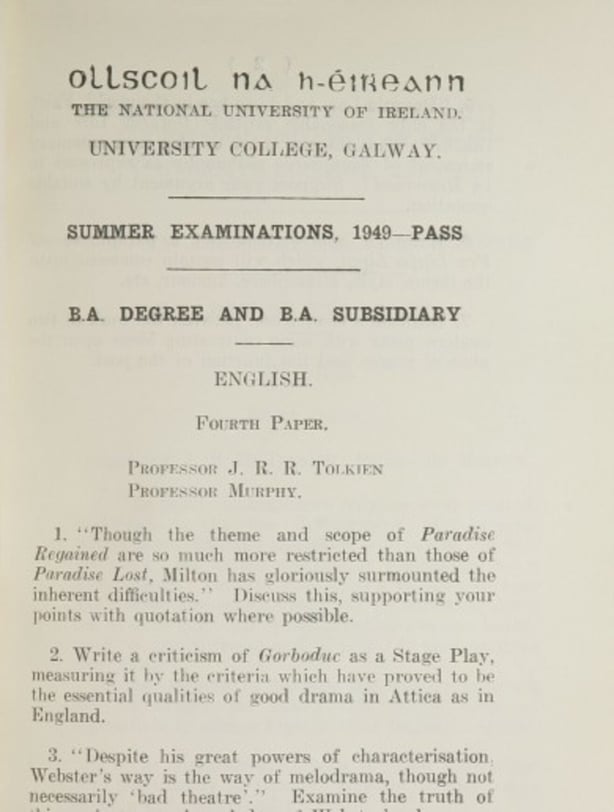Analysis: the Lord of the Rings' author had many connections to the Burren, Galway and Connemara
As one of the world’s most celebrated authors, J.R.R. Tolkien's books have been made into numerous epic film and television series, as well as enchanting generations of readers. Fifty years after his death in 1973, Tolkien is synonymous with creating the vast fantasy tales and landscape of Middle Earth. But what are the Irish connections?
In July 1954, The Fellowship of the Ring was first published. The first volume in Tolkien’s epic three-volume saga that comprised The Lord of the Rings, was reviewed in the Irish Times where its connections to Ireland as well as its international contemporary influences were explored.
While the book contains resonances and portents to contemporary European politics and the omens of past and present holocausts, the nature of its story-telling could also be likened to Irish mythology. "Professor Tolkien has created", the critic noted, "races and fauna which may remind one of the Norse and Celtic legends more contemporally", while further adding that the stories, characters, themes, and places "ring familiarly in memory’s ear".
Dr Francis McCormick from the University in Galway on Tolkien and his thoughts on Ireland
It has been argued and debated for decades that the remarkable landscape of the Burren in Co. Clare inspired the landscape of Middle-Earth. While that still may be uncertain, what is certain is that Tolkien had many connections with the West of Ireland and did indeed visit the Burren, Galway, Connemara and the West of Ireland on numerous occasions.
On four occasions Tolkien, then Professor of English Language and Literature at Merton College, University of Oxford, served as an external examiner at the Department of English in University College Galway (UCG or University of Galway as it is today) in 1949, 1950, 1954 and 1959. The original exam papers accessible within Special Collections of University of Galway Library show Tolkien named as the examiner alongside Prof Diarmaid Murphy, then Professor of English at Galway. Murphy was a popular figure on campus, involved in student societies and encouraged the growth of the university drama society of the time.

The exam papers show a wide ranging and challenging paper, with questions on topics and subjects that would have appealed to Tolkien’s linguistic interests. Questions ranged from works by Shakespeare, Edmund Spensor and John Milton, as well as essays on meaning in writing and change affected by accent and stress in literature.
While examining student essays on campus at UCG, Tolkien stayed in the heart of the Burren, with friends, the Martyn family, at Gregan's Castle in Ballyvaughan. On many walks in the famous Burren landscape, Tolkien could not avoid names such as Pollnagollum, the site of the longest cave system in Ireland, at over 16km long. Is this the inspiration for the character of Gollum in Tolkien’s epic saga? A major survey of the cave system was published by J.C. Coleman and N.J. Dunnington in the Proceedings of the Royal Irish Academy in 1944-1945, a full decade before The Fellowship of the Ring published.
Further Irish connections to Tolkien came through the award of an honorary Doctorate of Literature by the National University of Ireland (NUI) in 1954. Coinciding with the visit to University College Galway by Tolkien in 1954, the year was also the centenary of the NUI. At a ceremony in Dublin, 17 scholars, including Tolkien, were recognised.
From 1968, BBC's Tolkien in Oxford documentary
A high mass was held to mark the occasion at St. Andrew's Church, Westland Row in Dublin. The sermon was delivered by Archbishop of Dublin John Charles McQuaid, who was also Rector of the NUI. Tolkien’s Catholicism was also at least a part-factor, as well as his literary genius, in receiving the accolade.
The citation for the award made to Tolkien was given by Prof Jeremiah Hogan, who had attended University of Oxford as a student and had attended Tolkien's first lecture at the University in 1925. Thirty years later, Hogan spoke of Tolkien’s first lecture, 'its freshness, informality and vigour.’ Hogan described the connections to John Henry Newman and his founding ideals for a university (and a Catholic University) and to Tolkien’s legacy to come. Alluding to the impending publication of The Fellowship of the Ring, Hogan said, "At this moment [Tolkien] is about to break upon the world with a very large work of romantic fiction, a work in the tradition, I have been told, of Malory and Spenser".
The stories of Middle Earth show tales of friendship, journeying, loss, and perseverance
Hogan further outlined the connections between English at the NUI and at University of Oxford, and the work of Thomas Arnold. Newman appointed Arnold to Professor of English at the Catholic University. A noted medievalist and Anglo-Saxon scholar, Arnold's academic interests overlapped with much of Tolkien’s. Hogan completed his citation address in honour of Tolkien by highlighting the lasting links in the study of Anglo-Saxon by concluding that "Our English school thus derived from Oxford", the ongoing legacy of which was the work and teaching of Tolkien.
The stories of Middle Earth show tales of friendship, journeying, loss, and perseverance. In the books, Tolkien's writing presents landscape and the environment as a central facet and 'character’ in its own right. While it may still be ambiguous if Middle-Earth and the West of Ireland are one and the same, what is perhaps more important to consider is the books themselves as well as Tolkien's links to Ireland and the West of Ireland in particular.
The views expressed here are those of the author and do not represent or reflect the views of RTÉ








